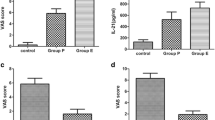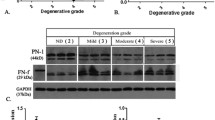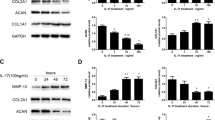Abstract
Introduction
Increased levels of proinflammatory cytokines seem to play a pivotal role in the development of back pain in a subpopulation of patients with degenerative intervertebral disc (IVD) disease. As current treatment options are mostly limited to surgical interventions or conservative treatment, anti-inflammatory substances might offer a novel, more target-orientated therapeutic approach. Triptolide (TPL), a natural substance found in the Chinese medicinal herb Tripterygium wilfordii Hook, has been demonstrated to possess anti-inflammatory effects in various cells, but no studies exist so far for the IVD. Therefore, the aim of this study was to determine the effects of TPL on human IVD cells by analyzing changes in gene expression and underlying molecular mechanisms.
Materials and methods
In order to investigate the anti-inflammatory, anabolic and anti-catabolic effect of TPL, dose-dependency experiments (n = 5) and time course experiments (n = 5) were performed on IL-1β prestimulated human IVD cells and changes in gene expression of IL-6/-8, TNF-α, PGE2S, MMP1/2/3/13, aggrecan and collagen-I/-II were analyzed by real-time RT-PCR. The molecular mechanisms underlying the effects observed upon TPL treatment were investigated by analyzing involvement of Toll-like receptors TLR2/4 (real-time RT-PCR, n = 5), NF-κB, MAP kinases p38, ERK and JNK (immunoblotting and immunocytochemistry, n = 4) as well as RNA polymerase II (immunoblotting, n = 3).
Results
Results showed that 50 nM TPL exhibited an anti-inflammatory, anti-catabolic and anabolic effect on the mRNA level for IL-6/-8, PGE2S, MMP1/2/3/13, aggrecan, collagen-II and TLR2/4, with most pronounced changes after 18 h for proinflammatory cytokines and MMPs or 30 h for TLRs and matrix proteins. However, we also observed an up-regulation of TNF-α at higher concentrations. The effects of TPL did not seem to be mediated via an inhibition of NF-κB or a decrease of RNA polymerase II levels, but TPL influenced activity of MAP kinases p38 and ERK (but not JNK) and expression of TLR2/4.
Conclusions
In conclusion, TPL may possess promising potential for the treatment of inflammation-related discogenic back pain in vitro, but its analgetic effect will need to be confirmed in an appropriate in vivo animal model.




Similar content being viewed by others
References
Chen BJ (2001) Triptolide, a novel immunosuppressive and anti-inflammatory agent purified from a Chinese herb Tripterygium wilfordii Hook F. Leuk Lymphoma 42:253–265
Qiu D, Kao PN (2003) Immunosuppressive and anti-inflammatory mechanisms of triptolide, the principal active diterpenoid from the Chinese medicinal herb Tripterygium wilfordii Hook. f. Drugs R D 4:1–18
Brinker AM, Ma J, Lipsky PE, Raskin I (2007) Medicinal chemistry and pharmacology of genus Tripterygium (Celastraceae). Phytochemistry 68:732–766
Yu DY (1983) Clinical observation of 144 cases of rheumatoid arthritis treated with glycoside of Radix Tripterygium Wilfordii. J Tradit Chin Med 3:125–129
Pan J (2010) RNA polymerase—an important molecular target of triptolide in cancer cells. Cancer Lett 292:149–152
Suzuki M, Inoue G, Gemba T, Watanabe T, Ito T, Koshi T, Yamauchi K, Yamashita M, Orita S, Eguchi Y, Ochiai N, Kishida S, Takaso M, Aoki Y, Takahashi K, Ohtori S (2009) Nuclear factor-kappa B decoy suppresses nerve injury and improves mechanical allodynia and thermal hyperalgesia in a rat lumbar disc herniation model. Eur Spine J 18:1001–1007
Yamashita M, Ohtori S, Koshi T, Inoue G, Yamauchi K, Suzuki M, Takahashi K (2008) Tumor necrosis factor-alpha in the nucleus pulposus mediates radicular pain, but not increase of inflammatory peptide, associated with nerve damage in mice. Spine (Phila Pa 1976) 33:1836–1842
Kallakuri S, Takebayashi T, Ozaktay AC, Chen C, Yang S, Wooley PH, Cavanaugh JM (2005) The effects of epidural application of allografted nucleus pulposus in rats on cytokine expression, limb withdrawal and nerve root discharge. Eur Spine J 14:956–964
Cuellar JM, Montesano PX, Carstens E (2004) Role of TNF-alpha in sensitization of nociceptive dorsal horn neurons induced by application of nucleus pulposus to L5 dorsal root ganglion in rats. Pain 110:578–587
Olmarker K, Blomquist J, Stromberg J, Nannmark U, Thomsen P, Rydevik B (1995) Inflammatogenic properties of nucleus pulposus. Spine (Phila Pa 1976) 20:665–669
Burke JG, Watson RW, McCormack D, Dowling FE, Walsh MG, Fitzpatrick JM (2002) Intervertebral discs which cause low back pain secrete high levels of proinflammatory mediators. J Bone Joint Surg Br 84:196–201
Le Maitre CL, Freemont AJ, Hoyland JA (2005) The role of interleukin-1 in the pathogenesis of human intervertebral disc degeneration. Arthritis Res Ther 7:R732–R745
Weiler C, Nerlich AG, Bachmeier BE, Boos N (2005) Expression and distribution of tumor necrosis factor alpha in human lumbar intervertebral discs: a study in surgical specimen and autopsy controls. Spine (Phila Pa 1976) 30:44–53 discussion 54
Shamji MF, Setton LA, Jarvis W, So S, Chen J, Jing L, Bullock R, Isaacs RE, Brown C, Richardson WJ (2010) Proinflammatory cytokine expression profile in degenerated and herniated human intervertebral disc tissues. Arthritis Rheum 62:1974–1982
Bachmeier BE, Nerlich AG, Weiler C, Paesold G, Jochum M, Boos N (2007) Analysis of tissue distribution of TNF-alpha, TNF-alpha-receptors, and the activating TNF-alpha-converting enzyme suggests activation of the TNF-alpha system in the aging intervertebral disc. Ann N Y Acad Sci 1096:44–54
Lin N, Liu C, Xiao C, Jia H, Imada K, Wu H, Ito A (2007) Triptolide, a diterpenoid triepoxide, suppresses inflammation and cartilage destruction in collagen-induced arthritis mice. Biochem Pharmacol 73:136–146
Gong Y, Xue B, Jiao J, Jing L, Wang X (2008) Triptolide inhibits COX-2 expression and PGE2 release by suppressing the activity of NF-kappa B and JNK in LPS-treated microglia. J Neurochem 107:779–788
Kim YH, Lee SH, Lee JY, Choi SW, Park JW, Kwon TK (2004) Triptolide inhibits murine-inducible nitric oxide synthase expression by down-regulating lipopolysaccharide-induced activity of nuclear factor-kappa B and c-Jun NH2-terminal kinase. Eur J Pharmacol 494:1–9
Liou JT, Chen ZY, Ho LJ, Yang SP, Chang DM, Liang CC, Lai JH (2008) Differential effects of triptolide and tetrandrine on activation of COX-2, NF-kappa B, and AP-1 and virus production in dengue virus-infected human lung cells. Eur J Pharmacol 589:288–298
Lu Y, Fukuda K, Nakamura Y, Kimura K, Kumagai N, Nishida T (2005) Inhibitory effect of triptolide on chemokine expression induced by proinflammatory cytokines in human corneal fibroblasts. Invest Ophthalmol Vis Sci 46:2346–2352
Lin J, Chen L, Lin Z, Zhao M (2007) Inhibitory effect of triptolide on glioblastoma multiforme in vitro. J Int Med Res 35:490–496
Quero L, Klawitter M, Nerlich AG, Leonardi M, Boos N, Wuertz K (2010) Bupivacaine—the deadly friend of intervertebral disc cells? Spine J 11:46–53
Lin N, Sato T, Ito A (2001) Triptolide, a novel diterpenoid triepoxide from Tripterygium wilfordii Hook. f. suppresses the production and gene expression of pro-matrix metalloproteinases 1 and 3 and augments those of tissue inhibitors of metalloproteinases 1 and 2 in human synovial fibroblasts. Arthritis Rheum 44:2193–2200
Liacini A, Sylvester J, Zafarullah M (2005) Triptolide suppresses proinflammatory cytokine-induced matrix metalloproteinase and aggrecanase-1 gene expression in chondrocytes. Biochem Biophys Res Commun 327:320–327
Tao QS, Ren JA, Li JS (2007) Triptolide suppresses IL-1beta-induced chemokine and stromelysin-1 gene expression in human colonic subepithelial myofibroblasts. Acta Pharmacol Sin 28:81–88
Lu Y, Liu Y, Fukuda K, Nakamura Y, Kumagai N, Nishida T (2006) Inhibition by triptolide of chemokine, proinflammatory cytokine, and adhesion molecule expression induced by lipopolysaccharide in corneal fibroblasts. Invest Ophthalmol Vis Sci 47:3796–3800
Tao X, Schulze-Koops H, Ma L, Cai J, Mao Y, Lipsky PE (1998) Effects of Tripterygium wilfordii hook F extracts on induction of cyclooxygenase 2 activity and prostaglandin E2 production. Arthritis Rheum 41:130–138
Bergmann MW, Loser P, Dietz R, von Harsdorf R (2001) Effect of NF-kappa B Inhibition on TNF-alpha-induced apoptosis and downstream pathways in cardiomyocytes. J Mol Cell Cardiol 33:1223–1232
Liu Q (2010) Triptolide and its expanding multiple pharmacological functions. Int Immunopharmacol 11:377–383
Sasaki N, Kikuchi S, Konno S, Sekiguchi M, Watanabe K (2007) Anti-TNF-alpha antibody reduces pain-behavioral changes induced by epidural application of nucleus pulposus in a rat model depending on the timing of administration. Spine (Phila Pa 1976) 32:413–416
Acknowledgments
This study was made possible by grants from AOSpine (SRN 02/103 and AOSBRC-07-03). Its contents are solely the responsibility of the authors and do not necessarily represent the official views of AOSpine. The authors gratefully acknowledge Andreas Plewnia for technical assistance.
Conflict of interest
None.
Author information
Authors and Affiliations
Corresponding author
Rights and permissions
About this article
Cite this article
Klawitter, M., Quero, L., Klasen, J. et al. Triptolide exhibits anti-inflammatory, anti-catabolic as well as anabolic effects and suppresses TLR expression and MAPK activity in IL-1β treated human intervertebral disc cells. Eur Spine J 21 (Suppl 6), 850–859 (2012). https://doi.org/10.1007/s00586-011-1919-y
Received:
Accepted:
Published:
Issue Date:
DOI: https://doi.org/10.1007/s00586-011-1919-y




